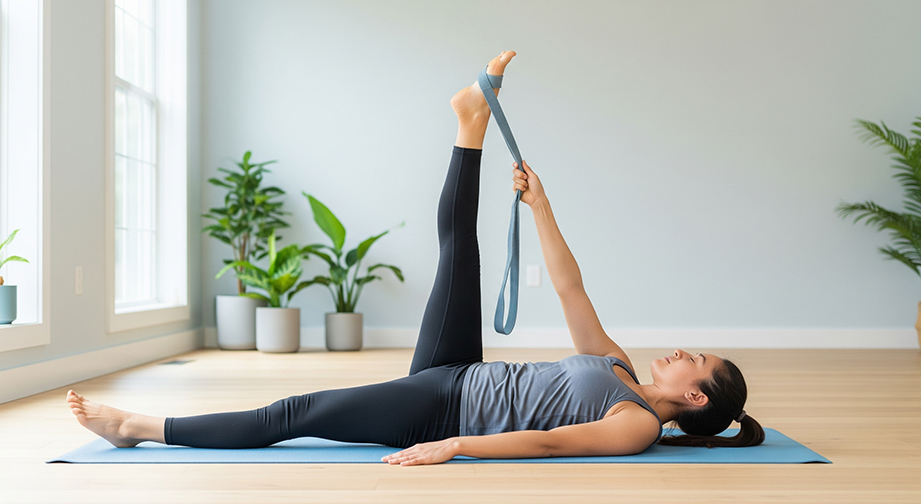Supta Padangusthasana (Reclining Big Toe Pose): A Complete Guide for All Levels
Introduction
Supta Padangusthasana (pronounced: soup-tah pad-an-goosh-TAH-sana), also known as Reclining Big Toe Pose, is a calming yoga posture practiced lying on the back. Literally, its Sanskrit name means "Supta" = reclining, "Padangustha" = big toe, "Asana" = pose.
With its soothing, stretch-focused essence, Supta Padangusthasana is ideal for releasing tension and improving flexibility—especially in the hamstrings and lower back.
If you’ve ever felt stiff after sitting too long or wish you could simply “unwind” your legs and back, this pose is your best friend on the yoga mat!
Step-by-Step Guide to Supta Padangusthasana

- Set Up: Lie flat on your back, arms resting by your sides. Stretch both legs out long.
- Bend and Hug: On exhale, bend your right knee towards your chest, keeping your left leg extended and foot flexed.
- Strap or Toe Hold: Loop a yoga strap (or towel) around your right foot, or grasp your right big toe with your right hand (using peace fingers).
- Leg Extension: On inhale, gently straighten your right leg up toward the ceiling, as much as your flexibility allows. Keep your shoulders and head relaxed on the floor.
- Anchor & Breathe: Hold the strap (or toe) with both hands, shoulders relaxed. Keep the left leg grounded and press the left thigh into the mat.
- Stay & Breathe: Hold for 5–10 slow breaths (about 30-60 seconds).
Breathing pattern: Inhale to lengthen your spine, exhale to gently draw the leg closer.
- Release: On exhale, slowly bend the right knee, lower the leg, and pause with both legs extended before repeating on the left side.
- Suggested: 1–2 rounds per leg, or as feels good.
- Modification for Beginners: Keep the bottom knee slightly bent, use a strap, or place a blanket under the head.
- Intensification: Open the raised leg out to the side (keeping hips grounded), or take the leg across the body slightly for a deeper stretch (a twist variation).
Alignment & Safety Tips
- Key Alignment Cues:
- Keep both hips rooted to prevent tilting.
- Maintain the extended foot flexed for active engagement.
- Relax the neck and jaw; let the shoulders rest heavy.
- Common Mistakes:
- Puling the raised leg too close and lifting the hip off the floor.
- Bending the raised knee excessively—practice “comfortably straight.”
- Holding breath—keep breathing steady and smooth.
- Safety Precautions:
- Avoid if you have recent hip, hamstring, or lower back injuries, or post-surgery.
- Prenatal considerations: Practice with knees bent, use props, or consult your yoga teacher.
Benefits of Supta Padangusthasana
- Physical Benefits:
- Stretches hamstrings, calves, and lower back
- Improves hip mobility and flexibility
- Relieves sciatica and back tension
- Encourages better posture and body alignment
- Mental Benefits:
- Calms the nervous system
- Reduces stress and anxiety
- Supports mindfulness through breath awareness
- Energy/Chakra Connection:
- Grounds energy (Muladhara/root chakra support)
- Opens the energy flow along the spine (Sushumna nadi)
Contraindications
- Hamstring/hip injury or recent surgery
- Severe lower back pain, sciatica flare-up (use support or skip the pose)
- Pregnancy (later stages): Use props and avoid deep stretch
- Alternatives: Supine knee-to-chest (Apanasana), Legs-up-the-wall (Viparita Karani)
Beginner’s Tips & Variations
- Use props: Strap for the foot, block under the lifted leg or calf, blanket under head.
- Gentle version: Keep knee bent or only lift the heel off the floor.
- Advanced variation: Bring leg out to the side (abduction), or across the body (Reclining Twist with toe hold).
How to Include Supta Padangusthasana in a Yoga Flow
- Best as a warm-up for hamstrings and hips, or in cool-down sequences for relaxation.
- Pairs well with: Downward Dog (Adho Mukha Svanasana), Bridge Pose (Setu Bandhasana), and Happy Baby (Ananda Balasana).
Mind-Body Connection
Practicing Supta Padangusthasana encourages you to tune into your breath and body sensations. As you settle into the stretch, notice areas of tightness vs. ease. This single-minded attention supports mindfulness, and a deep sense of calm can arise as you ground down, both physically and energetically.
Tip: Imagine breathing energy down your leg into the earth, grounding and releasing tension.
Summary Box
Asana Name: Supta Padangusthasana (Reclining Big Toe Pose)
Level: Beginner
Focus Areas: Hamstrings, hips, calves, lower back
Duration: 30–60 seconds per leg, 1–2 rounds
Best Time to Practice: Morning or Evening, or anytime you need a good stretch
Frequently Asked Questions about Supta Padangusthasana
Is Supta Padangusthasana safe for beginners?
Yes! With props and gentle modifications, it’s ideal for all levels. Always listen to your body and avoid overstretching.
What if I can’t reach my foot?
Use a yoga strap, scarf, or towel around your foot to make the posture accessible and comfortable.
How often should I practice Supta Padangusthasana?
Daily or several times a week to improve flexibility and relieve tension.
Should I flex or point my foot in the raised leg?
Flex (pull toes toward you) to activate the leg and protect the hamstring.